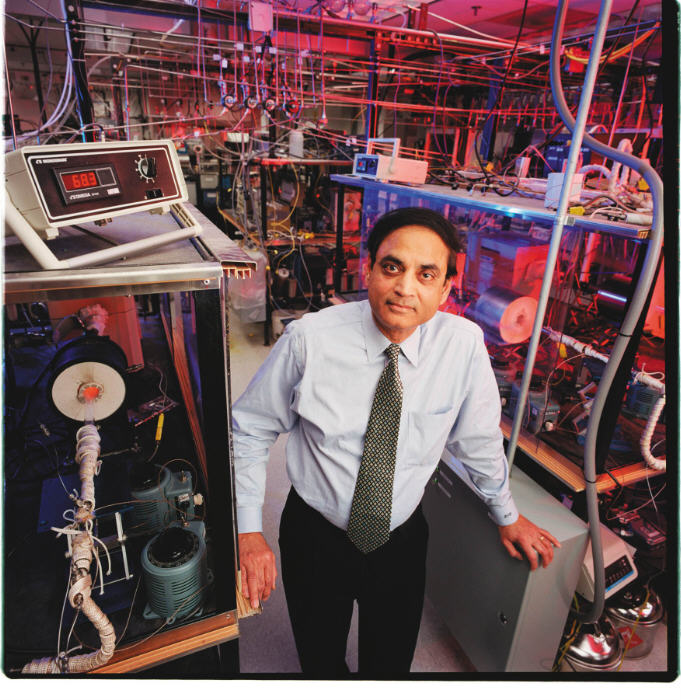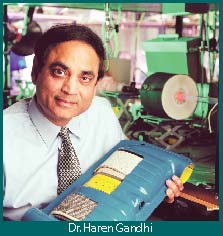

President Bush honoured Dr. Haren Gandhi for his work in automotive emissions control
December 13, 2003
President Bush honoured Haren Gandhi for his work in automotive emissions control in reducing pollution and improving air quality in the US and India. His work has lead to the development and improvement of the catalytic converter for automobiles that reduces the amount of exhaust pollutants by changing some of the exhaust into innocuous substances that do not harm the atmosphere.His advances in curbing harmful emissions, developed during his years at Ford Motor Company, have spread throughout the U.S. auto industry and around the world.His research has found ways to reduce by 50 per cent the use of precious metals in the catalytic converters. This advance can cut in half the cost of the device.It has also led to improvements in the recycling of the precious metals from discarded catalytic converters. We effectively recycle 98-99 per cent of the precious metals.
Gandhi has also worked to help India to monitor and improve the emission control in its vehicles for the lastr 20 years,
Emissions from U.S. automobiles have been reduced by more than 96 per cent from the levels of the 1960s, and Gandhi's pioneering work is an important factor in this advancement.
NRI, Dr. Haren Gandhi, the highest-ranking scientist/engineer at Ford Motor Company has won the 2002 National Medal of Technology for research, development and commercialisation of automotive exhaust catalyst technology.
Oct. 23, 2003
Secretary of Commerce Don Evans today congratulated the recipients of the 2002 National Medal of Technology, the nation’s highest honor for technological innovation.
“I join the President in honoring this year’s National Medal of Technology laureates,” said Secretary Evans. “Their revolutionary innovations and discoveries in microelectronics and materials science, clean air technologies and industrial leadership to improve our environment have given American producers a leading competitive edge on a global level and set a high standard for excellence. As teachers, role models and managers of change, they have transformed personal achievement into inspiration for future generations of innovators.”
The 2002 National Medal of Technology laureates announced that Haren S. Gandhi, Ford Motor Company, Dearborn, Mich. – a research pioneer in automotive technology to improve environmental standards, “For research, development, and commercialization of automotive exhaust catalyst technology, shaping the industry from its very beginning and continually pushing to improve the quality of the air we breathe. Dr. Gandhi has also led the automotive industry in ensuring the judicious use of precious metals, including conservation measures such as recycling of spent converters and technological advances in precious metal utilization.”
Dr. Gandhi has also conducted pioneering research in the areas of three-way catalysts (TWC), catalysts for alternative fuels, oxygen storage components in TWCs, poisoning of automotive catalysts, and novel catalyst formulation strategies.
His work has resulted in over 70 technical publications and over 40 U.S. patents in automotive exhaust catalysis and related areas.
As a top official of Ford Motor Company, Gandhi favors the use of CNG in India, calling it the best fuel available for Delhi at present. “On fuel basis CNG is the cleanest and most environment-friendly fuel available at present for Delhi,” said Gandhi at an Auto Expo in India.
Born in Calcutta on May 2, 1941 and raised in Bombay, Gandhi earned a degree in chemical engineering from Bombay University, before receiving his doctorate at the University of Detroit. Gandhi joined Ford in 1967 as a research engineer and has held a number of research engineering and staff scientist positions within the company.
Dr Gandhi’s distinctions is his recent election to ( (NAE) the National Academy of Engineering. He has had an illustrious career wherein he has won includes numerous technical awards, including five Henry Ford Technological Awards in 1985, 1988, 1989 and two in 1994. He has published more than 70 technical publications and over 40 US patents in automotive exhaust catalysis and related areas.
Click here: